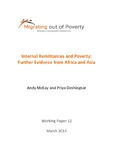| dc.contributor.author | McKay, Andy | |
| dc.contributor.author | Deshingkar, Priya | |
| dc.date.accessioned | 2019-12-12T15:52:21Z | |
| dc.date.available | 2019-12-12T15:52:21Z | |
| dc.date.issued | 2014-03-01 | |
| dc.identifier.citation | McKay, A. and Deshingkar, P. (2014) Internal Remittances and Poverty: Further Evidence from Africa and Asia, Migrating out of Poverty Working Paper 12 | |
| dc.identifier.uri | https://opendocs.ids.ac.uk/opendocs/handle/20.500.12413/14882 | |
| dc.description.abstract | Despite the fact that the number of internal migrants globally is at least 740 million, nearly four times the number of international migrants, there is hardly any discussion on internal remittances and their potential to reduce poverty. Families that 'send' internal migrants are, on average, poorer than those of international migrants, and the receipt of remittances, even if smaller in amount than international remittances, has the potential to improve standards of living and overall wellbeing with possible multiplier effects for origin areas. Building on earlier work on Ghana and India, this paper examines secondary data from household surveys for six countries in Africa and Asia (Nigeria, Rwanda, South Africa, Uganda, Bangladesh and Vietnam), to show the significance of internal remittances as well as the characteristics of receiving areas and households. The paper shows that internal migrants outnumber international migrants in most of the countries under study and that internal remittances flow to a larger number of receiving households, mainly in poor rural areas. An examination of the patterns of internal migration and the drivers for migration shows that most migrants originate from poorer regions and go to richer regions. Although it is not possible to establish causality or address endogeneity on the basis of these data and computations alone, the mapping and assessment of internal remittances provides a useful picture of the significance of these monetary flows in poor countries and challenges the notion that internal remittances need not be considered in development planning. While we do not claim to establish that these remittances are reducing poverty, they are received in significant magnitudes by poor households, and complementary evidence shows that migration is usually undertaken to improve living standards and overall wellbeing. | |
| dc.description.sponsorship | DFID | |
| dc.language.iso | en | |
| dc.publisher | Migrating out of Poverty | |
| dc.title | Internal Remittances and Poverty: Further Evidence from Africa and Asia | |
| dc.type | Other | |
| dc.rights.holder | University of Sussex. Short sections of text, not to exceed two paragraphs, may be quoted without explicit permission provided that full credit, including © notice, is given to the source. | |
| dc.identifier.externaluri | http://www.migratingoutofpoverty.org/files/file.php?name=wp-12---mckay-and-deshingkar-internal-remittances-and-poverty.pdf&site=354 | |
| dc.rights.license | Short sections of text, not to exceed two paragraphs, may be quoted without explicit permission provided that full credit, including © notice, is given to the source | |

